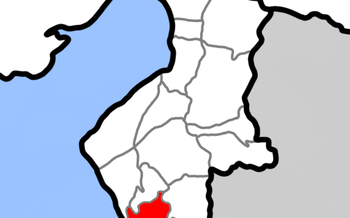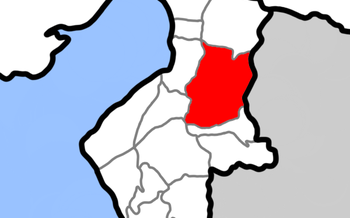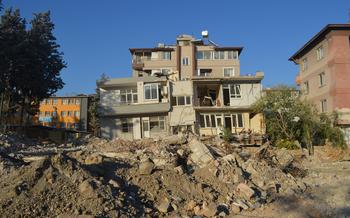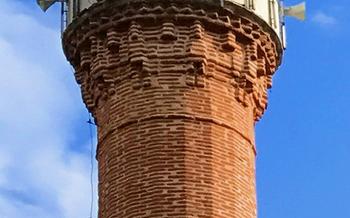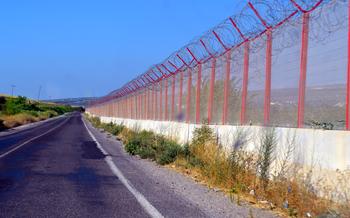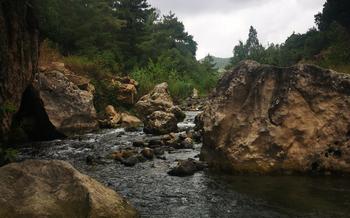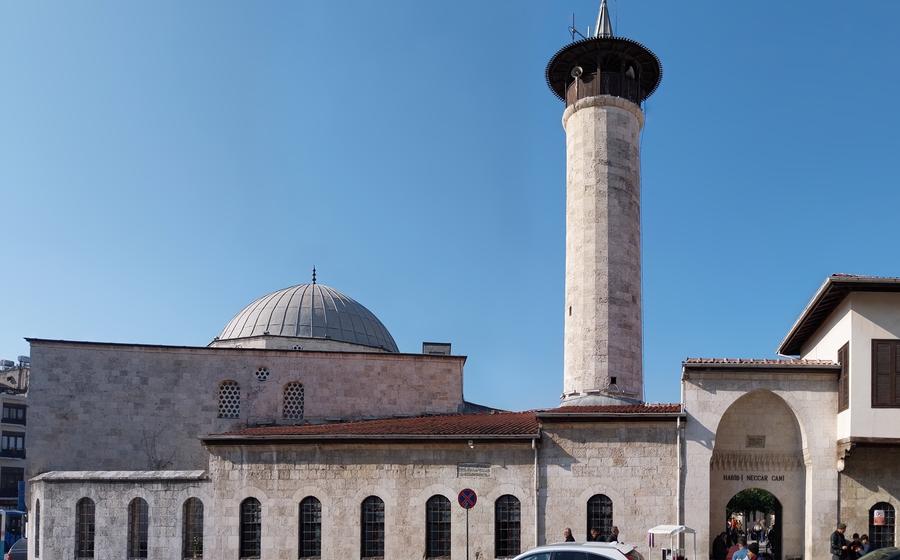
Habibi Neccar Mosque
- Historical Significance
- Architectural Marvel
- Religious Significance
- Mosaics and Frescoes
- Prayer Hall
- Courtyard
- Minaret
- Dome
- Niche
- Fountain
- Gardens
- Festivals and Events
- Local Cuisine
- Insider Tip: Discover a Hidden Oasis
Historical Significance
The Habibi Neccar Mosque, also known as the Tomb of Saint Simon the Zealot, holds immense historical and religious significance. Built in the 7th century AD, it is believed to be the final resting place of Saint Simon, one of the twelve apostles of Jesus Christ. According to tradition, Saint Simon traveled to Antioch, the ancient capital of the Roman province of Syria, to spread Christianity. He was martyred there and his remains were later interred where the mosque now stands. The mosque's name, Habibi Neccar, means "friend of the carpenter" in Arabic, a reference to Saint Simon's profession before becoming an apostle.
Architectural Marvel
The Habibi Neccar Mosque stands as a testament to the architectural prowess of its era. Its unique design blends elements from both Islamic and Byzantine traditions, creating a stunning masterpiece. The mosque's exterior facade is adorned with intricate carvings and colorful tiles, while its interior boasts a spacious prayer hall with a soaring dome.
One of the mosque's most striking features is its minaret, which rises high above the surrounding cityscape. The minaret's slender form and intricate detailing make it a true work of art. Visitors can climb to the top of the minaret for breathtaking views of the city and the surrounding countryside.
The mosque's prayer hall is a sight to behold, with its grand arches, intricate mosaics, and ornate chandeliers. The mihrab, or prayer niche, is particularly stunning, featuring intricate carvings and colorful tiles. The dome of the prayer hall is another highlight, with its beautiful geometric patterns and vibrant colors.
The best time to visit the Habibi Neccar Mosque is during the early morning or late afternoon, when the sunlight casts a warm glow on the mosque's exterior and the interior is bathed in a soft, ethereal light. This is when the mosque's architecture is at its most stunning, and visitors can truly appreciate the beauty and craftsmanship that went into its construction.
Religious Significance
The Habibi Neccar Mosque holds immense religious significance for Muslims worldwide, making it a revered pilgrimage site. The mosque is believed to be the burial place of Habibi Neccar, a revered figure mentioned in the Quran as a carpenter who embraced the teachings of Prophet Jesus (PBUH). According to Islamic tradition, Habibi Neccar was martyred for his faith, and his tomb within the mosque attracts countless pilgrims seeking blessings and spiritual connection.
When visiting the mosque, it is essential to observe proper etiquette out of respect for its sacred nature. Upon entering, visitors should remove their shoes and maintain a modest demeanor. Women are advised to cover their hair and wear appropriate clothing that covers their shoulders and knees. While inside the mosque, visitors should maintain silence and avoid engaging in loud conversations or disruptive behavior. It is customary to perform ablution before entering the prayer hall, and there are designated areas for this purpose within the mosque complex. By adhering to these guidelines, visitors can demonstrate respect for the religious customs and traditions associated with the Habibi Neccar Mosque.
Mosaics and Frescoes
The interior of the Habibi Neccar Mosque is adorned with stunning mosaics and frescoes that depict scenes from the life of the Prophet Muhammad and his companions. These intricate artworks, created by skilled artisans, showcase a blend of Byzantine and Islamic influences. The mosaics are particularly impressive, with vibrant colors and lifelike figures that seem to come alive before your eyes.
Symbolism and Techniques:
The mosaics and frescoes in the Habibi Neccar Mosque are not merely decorative elements; they also carry deep symbolic meanings. For example, the depiction of the Prophet Muhammad's journey to heaven, known as the Mi'raj, symbolizes the spiritual ascent of the soul towards enlightenment. The use of geometric patterns, such as arabesques and Kufic script, represents the harmony and order of the universe.
The techniques used to create these artworks are as remarkable as the subjects they depict. The mosaics are composed of thousands of tiny tesserae, or tiles, which are arranged to form intricate patterns and images. The frescoes, on the other hand, are painted directly onto the walls using natural pigments and binders. The result is a testament to the skill and artistry of the craftsmen who created these masterpieces.
Prayer Hall
The prayer hall of the Habibi Neccar Mosque is a breathtaking display of Islamic architecture and artistry. Its vast space is adorned with intricate mosaics, elegant calligraphy, and shimmering chandeliers. The mihrab, or prayer niche, is the focal point of the hall, beautifully decorated with colorful tiles and carvings. The floor is covered in soft carpets, inviting worshippers to pray in comfort and tranquility.
Before entering the prayer hall, it is important to dress appropriately. Men should wear long pants and a shirt that covers their shoulders, while women should wear a headscarf, long sleeves, and a long skirt or dress. It is customary to remove your shoes before entering the hall, as a sign of respect for the sacred space.
Once inside, take a moment to admire the beauty of the surroundings. The acoustics of the hall are designed to amplify the imam's voice during prayers, creating a resonant and spiritual atmosphere. The natural light filtering through the stained-glass windows casts a warm glow, adding to the serene ambiance.
If you are not a Muslim, you are still welcome to visit the prayer hall, but it is important to be respectful of those who are praying. Avoid talking or making noise, and do not walk in front of someone who is prostrating. Simply observe the beauty of the hall and the devotion of the worshippers, and allow yourself to be transported by the spiritual energy of this sacred space.
Courtyard
The courtyard of the Habibi Neccar Mosque is a tranquil and serene space, designed to provide a place for contemplation and reflection. Surrounded by elegant arches and intricate tilework, the courtyard is a beautiful example of Islamic architecture. In the center of the courtyard, a fountain provides a soothing backdrop to the peaceful atmosphere.
The courtyard is a popular spot for visitors to relax and take a break from the bustling city. It's a great place to sit and admire the beauty of the mosque, or to simply close your eyes and enjoy the tranquility. The courtyard is also a popular spot for prayer, as it provides a quiet and secluded space for worshippers to connect with their faith.
Tip: Spend some time relaxing and reflecting in the courtyard. Take a few moments to appreciate the beauty of the mosque and the peaceful atmosphere.
Minaret
The towering minaret of the Habibi Neccar Mosque stands as a majestic symbol of Islamic architecture. Constructed from intricately carved stone, the minaret rises gracefully towards the heavens, its slender form reaching for the clouds. Its primary function is to serve as a vantage point for the muezzin, or Islamic caller to prayer, who ascends the minaret five times a day to issue the melodious call to prayer, known as the adhan. The muezzin's voice reverberates through the airwaves, echoing across the rooftops and alleyways of Hatay, summoning the faithful to congregate for prayer.
One particular anecdote associated with the minaret speaks to the dedication and devotion of the muezzins who have served the mosque throughout history. During the Ottoman era, a muezzin named Mehmed Efendi was renowned for his exceptionally beautiful voice. His call to prayer was so enchanting that it would often draw crowds of people to the mosque, who would gather in the courtyard to listen to his melodious chanting. Mehmed Efendi's voice became synonymous with the Habibi Neccar Mosque, and his legacy lives on as a testament to the spiritual power of the adhan.
Dome
The majestic dome of the Habibi Neccar Mosque is a testament to the architectural prowess of the Ottoman Empire. Towering above the city, the dome's size and grandeur are awe-inspiring. Its intricate design, featuring geometric patterns and calligraphy, showcases the artistry and craftsmanship of the era.
The dome holds significant symbolic and spiritual meaning in Islamic architecture. It represents the heavens and the oneness of God. It also serves as a reminder of the vastness of the universe and the smallness of man. By gazing up at the dome, worshippers are reminded of the greatness of their Creator and the insignificance of worldly matters.
Architecturally, the dome is a marvel of engineering. Constructed without the use of modern technology, it has stood the test of time and remains structurally sound. The use of interlocking bricks and a unique mortar mixture contributed to the dome's durability. The dome's interior is adorned with beautiful paintings and inscriptions that add to its splendor.
When visiting the Habibi Neccar Mosque, take a moment to appreciate the grandeur of the dome. Marvel at its size, admire its intricate design, and reflect on its symbolism. It is a masterpiece that embodies the rich history and architectural legacy of Turkey.
Niche
Within the prayer hall, the mihrab, or prayer niche, stands as a focal point for the faithful. This intricately carved niche indicates the qiblah, the direction towards Mecca, which Muslims face during their prayers. The mihrab's design often reflects the mosque's architectural style, and in the Habibi Neccar Mosque, it is adorned with colorful tiles and intricate calligraphy.
Before entering the prayer hall, take a moment to locate the mihrab. It is usually positioned in the center of the qiblah wall, and its presence adds a sense of sacredness and reverence to the space. As you stand before the mihrab, imagine the countless generations of Muslims who have stood in the same spot, their hearts turned towards the holy city of Mecca.
Fountain
In Islamic architecture, fountains hold a significant place, serving both functional and symbolic purposes. Located in the courtyard of the Habibi Neccar Mosque, the fountain offers a place for visitors to cleanse themselves before entering the prayer hall, following the tradition of ablution. This ritual purification symbolizes the cleansing of one's body and soul before engaging in worship. The fountain's flowing water represents the purity and abundance of God's blessings.
As you approach the fountain, take a moment to appreciate its intricate design and the soothing sound of the water. You may notice locals and visitors alike using the fountain to wash their hands, feet, and face. If you wish to participate in this practice, it is recommended to bring your own towel or purchase one from a nearby vendor.
Remember that the fountain is not just a practical amenity but also a symbol of spiritual purification. By taking a moment to cleanse yourself at the fountain, you can set your intention for a meaningful and reverent visit to the Habibi Neccar Mosque.
Gardens
The Habibi Neccar Mosque is surrounded by lush gardens, a testament to the importance of nature in Islamic architecture. These gardens provide a tranquil oasis for visitors to relax and reflect, away from the hustle and bustle of the city. The gardens are meticulously landscaped, with colorful flowers, fragrant shrubs, and towering trees. Water features, such as fountains and ponds, add a soothing ambiance to the space.
One of the most striking features of the gardens is the use of symmetry. The trees and shrubs are arranged in neat rows, creating a sense of order and harmony. The pathways are also symmetrical, leading visitors through the gardens in a meandering fashion. This symmetry is not only aesthetically pleasing but also reflects the Islamic belief in the perfection and order of the universe.
The gardens also serve a practical purpose. They provide shade from the hot Turkish sun, making it a pleasant place to visit even during the summer months. The trees and shrubs also help to purify the air, creating a healthier environment for visitors.
In the Islamic tradition, gardens are often seen as a symbol of Paradise. The gardens surrounding the Habibi Neccar Mosque are no exception. They offer visitors a glimpse of the beauty and tranquility that await those who are faithful.
Festivals and Events
Throughout the year, the Habibi Neccar Mosque hosts a variety of festivals and events that showcase the rich cultural heritage of Hatay. One of the most notable events is the annual Habibi Neccar Festival, held in honor of the mosque's namesake. The festival features traditional music, dance, and food, as well as religious ceremonies and processions.
Practical Advice: To make the most of your visit, plan your trip to coincide with one of these special events. Check the mosque's website or contact the local tourism office for a calendar of upcoming events.
Local Cuisine
In the vicinity of the Habibi Neccar Mosque, you'll find an array of culinary delights that reflect Hatay's rich cultural heritage. Indulge in the flavors of traditional Turkish cuisine at nearby restaurants, where you can savor the aromatic kebabs, the savory yaprak sarma (stuffed vine leaves), and the delectable meze platters.
For a truly unforgettable experience, don't miss out on künefe, a delectable pastry that is synonymous with Hatay. This shredded filo dough dessert, filled with cheese and drenched in sweet syrup, is a local specialty that will tantalize your taste buds.
As you relish these culinary treasures, take the opportunity to engage with the friendly locals, who will gladly share stories and insights about their beloved city.
Insider Tip: Discover a Hidden Oasis
Within the tranquil confines of the Habibi Neccar Mosque lies a hidden gem, a secluded spot that offers breathtaking views and a moment of serene contemplation. To find this secret oasis, venture to the far end of the courtyard, where you'll discover a small, unassuming door. Step through the doorway, and you'll be greeted by a narrow staircase that leads to the roof of the mosque.
As you ascend the stairs, anticipation builds, and the sense of discovery heightens. Finally, you emerge onto the rooftop, and the panorama that unfolds before you is simply awe-inspiring. The cityscape of Hatay stretches out below, a vibrant tapestry of colors and textures, while the distant mountains form a majestic backdrop. The rooftops of neighboring buildings provide a unique perspective, showcasing the intricate details and architectural diversity of the city.
Here, amidst the tranquility of the rooftop, you can escape the hustle and bustle of the city and lose yourself in the beauty of the surroundings. Whether you choose to sit in silent contemplation, soak up the warmth of the sun, or simply marvel at the stunning views, this hidden spot offers a truly unforgettable experience.

